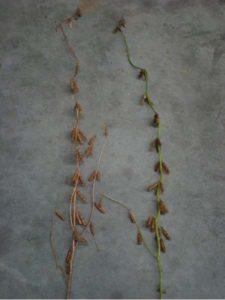Green stem syndrome is a disorder in soybean that results in mature pods and seeds hanging from green stems which can make harvest difficult. Plant stress from insects, diseases, and the environment can contribute to green stem syndrome. Fields with green stem syndrome should be monitored and harvested according to moisture content and combine settings adjusted accordingly.
What to Watch For
As soybean harvest begins, growers may notice areas of a field that have plants with seeds and pods that are mature while the stem remains green (Figure 1). This is a disorder commonly referred to as green stem syndrome. The main concern with green stem syndrome is that different parts of the plant are at different levels of readiness at harvest, which can make harvest difficult. Generally, soybean fields are harvested at a grain moisture content of around 13 to 14%.1 Soybean plants affected by green stem syndrome can have grain at 13% moisture content, but the stems are too green for efficient harvest. Harvest option considerations are:
- Harvest at the desired grain moisture content but struggle with decreased harvest efficiency due to slower speeds and potential cleaning of a plugged combine.
- Wait to harvest until stems have dried down with the potential to decrease yield through grain moisture loss and potential shattering.

Figure 1. Soybean plants grown side-by-side in the field. Typical plant on the left has mature pods and stem, while the plant on the right has symptoms of green stem syndrome with mature pods and a green stem. (Photo courtesy Shaun Casteel, Purdue University.)
Impact on Your Crop
The direct cause of green stem syndrome in soybean has been highly debated. Various sources have been investigated: insect infestations, viral diseases, and environmental stresses, all of which can cause reductions in pod number.2 While the specific causes of green stem syndrome can vary from year to year and location to location, plant stress like those listed above during pod and seed development seem to be a factor in the development of green stem syndrome.
During typical development, soybean plants redistribute sugars and nutrients (photosynthate) from the leaves and stems to the pods and seed. After the R5 growth stage, plant dry weight increases as the seeds grow and leaves cannot supply enough photosynthate to keep up. At R6 (full seed), plants begin to move the stored photosynthates from the leaves to developing seed and the leaves begin to turn yellow and fall from the plant.3 After the leaves have fallen, stored photosynthates from the stems are moved and stems turn brown. In plants where stress aborts pods or reduces seed number, there are more leaves and stems than needed to fill the remaining seeds. Therefore, once the needs of the remaining seeds have been met, excess photosynthate and moisture can remain in the stem, even through maturity. A study conducted at the University of Kentucky demonstrated that when 25 to 50% of pods were removed from a soybean plant at the R6 growth stage, pod maturation was not delayed, but stem maturation was delayed by 4 days to a month or longer. Green stem symptoms were more pronounced when a higher percentage of pods were removed.2 The exact cause will continue to be evaluated; however, due to the widespread occurrence of this condition through the soybean production regions, it is unlikely to be influenced by a single source.
Tips to Manage
There are a limited number of management options when faced with harvesting green stem soybeans. Green stems are difficult to cut and can lead to more wear and tear on harvesting equipment.
Tips for adjusting a combine to harvest soybean plants affected by green stem syndrome include:
- Ensuring the combine is in good operating condition, properly adjusted with sharpened cutting knife sections
- Harvesting with caution at slow speeds
Always refer to the manufacturer’s manual before performing any maintenance.
Depending on the severity of green stem syndrome in the field and the condition of the seeds and pods, it may be necessary to postpone harvest until after a killing frost. The downside to waiting for a frost or for the stems to dry down normally is an increased risk of yield loss from pods shattering in the field or during harvest. Fields should be monitored and harvested according to moisture content and combine settings should be adjusted accordingly. If waiting for frost is not an option, growers may consider using herbicides labeled as harvest aids in soybean. Two important things to consider prior to using a chemical harvest aid are the cost and the variability of maturity in your fields. Chemical harvest aids have shown inconsistent success desiccating soybeans for green stem. Harvest aids may be helpful to remove leaves, but are typically unable to dry down the stem itself.4 Closely monitor fields because yield may be diminished if an application is made before all soybean plants have reached the maturity required by the label. There is often a preharvest restriction between herbicide application and soybean harvest that must be followed. ALWAYS READ AND FOLLOW PESTICIDE LABEL DIRECTIONS.
Article Link – Green Stem Syndrome in Soybean
